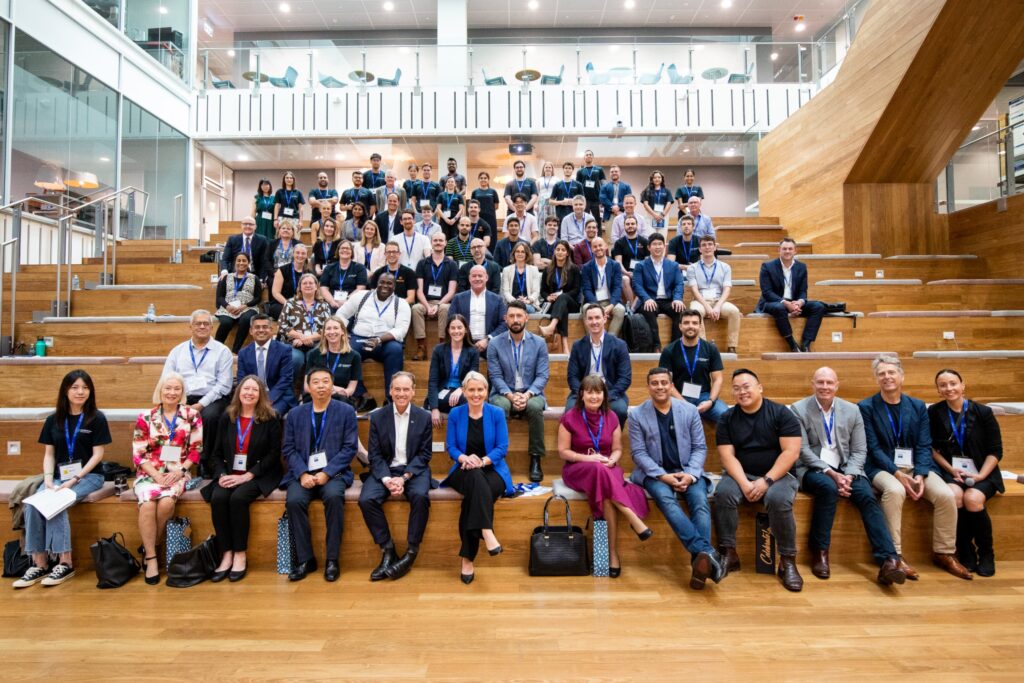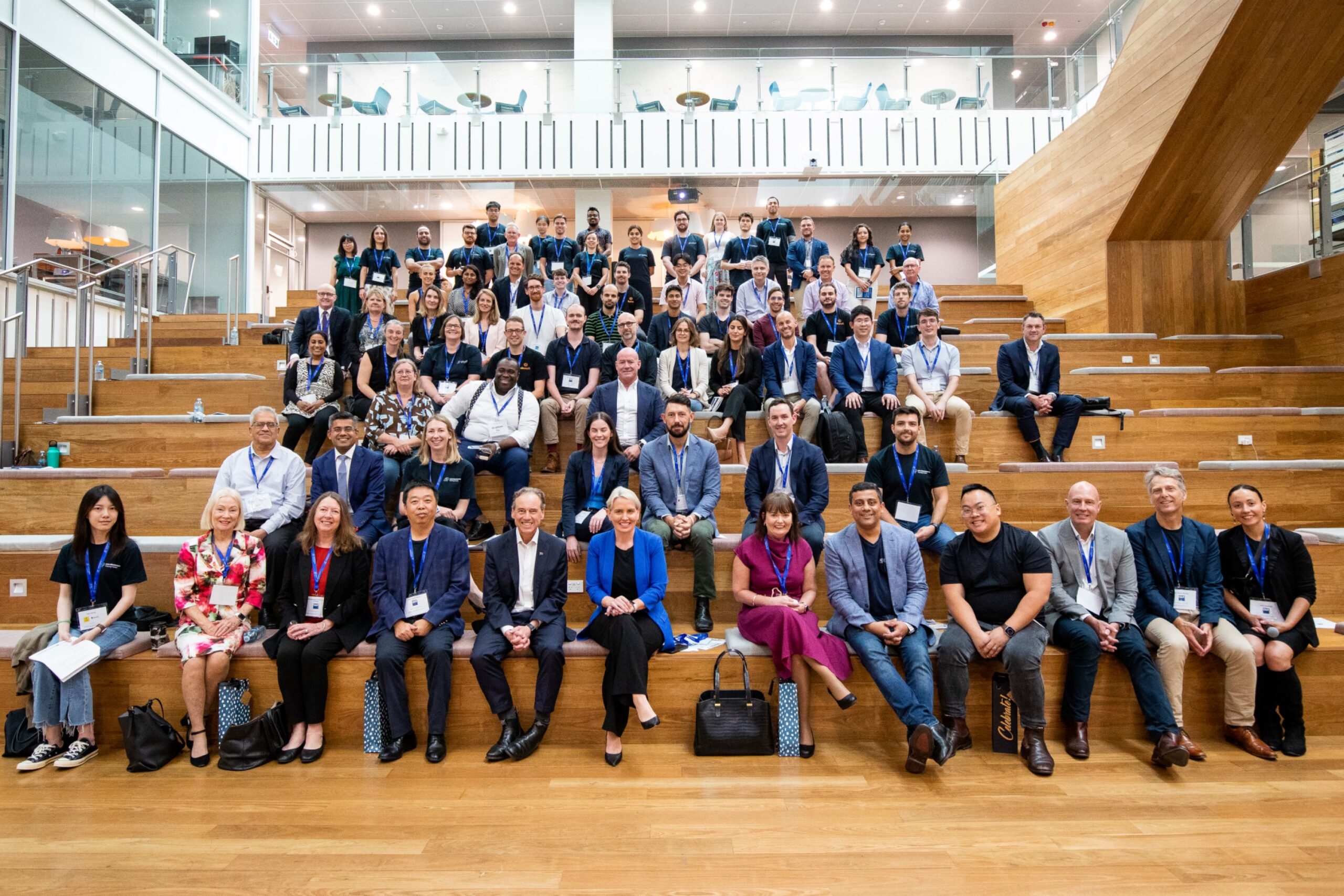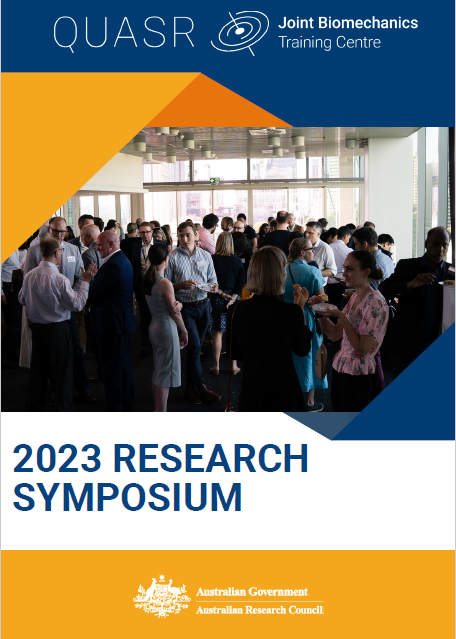Exchange of ideas and advancements in biomechanics (28 November, 2023)

The ARC Training Centre for Joint Biomechanics Symposium was a wonderful display of the centre’s current research to the wider academic community and industry partners. We heard throughout the day several informative presentations on the centre’s work, starting with the clinical presentation presented by Dr Jashint Maharaj for the clinical update, followed by the Seed Grant updates given by Dr Bart Bolsterlee, and Dr Maxence Lavaill Stepping in for Dr Dermot O’Rourke. Later in the day, there was a rapid-fire presentation giving more exact details on each project and celebrating the individuals who contributed exceptional effort to the centre in an award ceremony.
Dr Bart Bolsterlee delved into “Biomechanical Characteristics of The Human Supraspinatus Tendon In vivo Under Physiological Loading.” His presentation outlined the project’s aim, which is to establish a proof-of-principle for an anatomically and physiologically relevant computational model (finite element model) of the supraspinatus muscle-tendon complex.
Dr. Maxence Lavaill’s presentation of Dr. Dermot O’Rourke’s work, “Toward Precision Tracking of the Shoulder Joint Using Ultrasound Tomography,” was equally captivating. His presentation detailed the protocol’s development, focusing on the accuracy of the ultrasound-based system in determining bone positions concerning the motion capture system. This has profound implications for enhancing routine clinical assessment, post-op rehabilitation, and experimental shoulder biomechanics.
The end of session one was a panel discussion themed “Leadership in the Face of Change: Innovation & the Future of Med-Tech in Australasia,” where esteemed speakers shed light on leadership, innovation, and navigating healthcare’s technological landscape. This was led by Adj Prof Dr Ashish Gupta, with esteemed panel members Professor the Hon Greg Hunt, Dr Vu Tran, Ms Chris Went, Distinguished Prof. Lyn Griffiths, and Hon Kate Jones. Their discussions encompassed fostering innovation, navigating technological advancements, and addressing regulatory changes within the healthcare sector. Watch the panel discussion below:
Key moments noted in the panel were when the Hon Kate Jones emphasised the pivotal role of technology in the future and encouraged collaboration in leadership and self-development encouraging leaders to “surround[sic] yourself with brighter minds than you are, [that] is where the magic happens.” This idea was supported and extended by Distinguished Prof Lyn Griffiths, who underscored the need to embrace and cultivate different types of leaders and to recognise and support people who have the inclination to lead.
Further to the conversation on what makes a good leader, Dr Vu Tran weighed in on the importance of communication and soft skills and gave an insightful view on problem framing encouraging us to ask “not if we can, but how”.
With the change in discussion to planning, Professor The Hon Greg Hunt reflected on the pandemic response, acknowledging technology’s role in preparing and executing a swift response, noting that the telehealth system was finalised over 10 days in March 2020. This prompted the following advice that “unexpected moments often lead to significant developments, emphasising the importance of being open to the unforeseen”, by Chris Went.
Further insight in the discussion were key elements in active engagement, with Professor the Hon Greg Hunt’s asserting leadership is creating a dialogue which is then effective summarisation and communicates the plan with everyone in a way that brings engagement.
These takeaways are important points for building strong leadership, with the centre continuously reviewing ways to foster a culture of support for centre research and students, as it’s imperative for research projects to have strong drivers behind them.
Following session 1 and an exciting networking lunch with the attending industry, clinical and government guests, the centre showcased its research with rapid-fire presentations. Nine projects were presented, providing an opportunity to share insights into their work and develop concise communication skills.
Presentations:
- Insights into Different Optimization Methods for Solving the Shoulder Muscle Redundancy Problem presented by Dr Maxence Lavaill. His presentation provides glims into his research project that aims to create a method in which to validate the predictions of muscle and glenohumeral joint contact forces using EMG and GHJ-CF measurements.
- Three-Dimensional Architecture of Human Rotator Cuff Muscles presented by Yilan (Olivia) Zhang. Her research is focused on creating a more detailed arcuate model of the human rotator cuff muscles, though more varied and sensitive using measures (PCSA).
- Shoulder Morphologic Variations presented by François Bruyer-Montéléone. His research on Information on the variation
in the population of muscle activation patterns, i.e. internal biomechanical
loads to improve our understanding of the musculoskeletal system by using statistical shape models. - AI for Industry presented by Dr Laith Alzubaidi. Unveiling the potential of AI in shaping the future of industry and the trustworthy requirements necessary to move AI from the lab to the real world.
- Forward Prediction of Target Localisation Failure Through Pose Estimation Artefact Modelling presented by Morgan Windsor. Explored the potential for a system where surgical robots can detect when localisation failures are likely to occur, enabling a robot to anticipate and avoid them.
- Developing a Tissue Engineered Scaffold for Rotator Cuff Repair Surgery presented by Dr El Eleonore Bolle, Sepideh Shemshad, Asawari P, Stephanie Michelena, A collaborative effort to enhance healing outcomes post rotator cuff repair surgery by using computational modelling techniques and use of, induced pluripotent stem cell model which mimics features of ageing cells to investigate factors leading to the formation of scar tissue in ageing rotator cuff tissues following tears.
- How do We Activate Our Deltoid Muscles? Presented by Dr Wolbert van den Hoorn. He aims to map the neural drives of deltoid muscle activity by changing the level at which we observe this activity. This was achieved by High-density electromyography.
- Wearable Magneto-Inertial Measurement Units for Shoulder Kinematics presented by Arthur Fabre. He introduces a wearable system for upper limb and shoulder kinematics assessment to validate a novel MIMUs-based measurement method to obtain shoulder joint angles.
- Neuromuscular Control of the Shoulder Muscles presented by Yuyao (Amy) Ma. Her research aims to provide insight into how neuromuscular control of the shoulder is coordinated by the motor cortex of the brain in healthy individuals as a foundation for future investigation of people with pain.
The culmination of the event was the acknowledgment of the success of outstanding members of the centre research community, with awards provided to high achievers across collaboration, research excellence, and outstanding teamwork.
Congratulations to the recipients:
- Dr Wolbert Van Den Hoorn received the Engagement and Collaboration Award. This category pays tribute to individuals who have demonstrated exceptional skills in fostering collaboration and engagement within our research community.
- Dr Laith Alzubaidi received the Research Excellence and Performance Award. This award acknowledges individuals who have shown remarkable research performance based on key performance indicators across the 2023 calendar year. Dr Alzubaidi was further recognised for his recent promotion to Academic Level B, an outstanding achievement.
- Dr Maxence Lavaill received the Best Team Player Award. This award recognizes individuals who have demonstrated exceptional teamwork and cooperation in their research endeavours.
- Yilan (Olivia) Zhang and Natalia Mühl Castoldi received the Director’s HDR Award: Best Research Performance. This award recognizes outstanding
research performance among Higher degrees by Research candidates. - Morgan Windsor Director’s HDR Award: Best Centre Citizen. This award celebrates individuals who have demonstrated outstanding citizenship within the centre.
The centre operations team would like to extend their appreciation to the industry partners of the centre (Stryker, Melissa Anenden; Materialise; Monica Russell and Michael Mathews; Logemas; Dr Denny Wells; Greenslopes Private Hospital; Justin Greenwell, and Zimmer Biomet with Laura Zieth, Nicholas Flanigan, and Australian Biotechnologies) for their attendance and commitment to impactful, translational research with the centre.
The success of the day would not have been realised without centre manager Rosa Armitage putting in an incredible effort to ensure smooth logistics. Thank you also to Prof. YuanTong Gu and Mr Michael McArdle their welcome address, Prof Peter Pivonka for your overview of projects.


